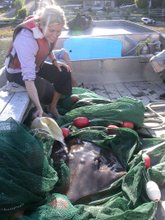If you catch a shark or skate while fishing or see one washed up on a beach, we want to hear from you! Here are some steps you can take quickly and with little equipment. Note if a beached shark is alive or shows any responsiveness - do NOT touch it. If you happen to catch the shark while fishing please take a photo and release the animal alive.
Essential information to record
- Record date, time and location including GPS coordinates (if possible)
- Length from tip of nose to tip of tail (use your foot length if no equipment is available)
- Behaviour - if alive what was it doing
- Sex – males have claspers
- Any marks, injuries or fishing gear that suggests how the animal may have died
Photograph details to take
- Whole animal, preferably the SIDE view (include hand or foot for scale)
- Underside of the head and under the pectoral fins
- Underside of the pelvic fins (verifies shark’s sex)
- Teeth, close-up (verifies species identification)
The great white shark (
Carcharodon carcharias) is one of the largest and most revered sharks in our waters. In Eastern North Pacific waters white sharks range from Alaska to Mexico, but are most common off the California coast. A very low number of white sharks have been identified in Pacific Canada, a total of 14 were recorded between 1961 and 2004. However, we have received 8 unconfirmed sightings of white sharks in waters off the west coast of Vancouver Island from 2000 to the present day. These white shark sightings were made by fishers and surfers. Sighting descriptions are usually of “smaller” white shark (3 to 4 metres) suggesting juvenile white sharks. Recent
satellite tagging research off the California coast suggest that juvenile white sharks spend a lot of their time in nearshore coastal waters, most likely looking for prey.
The only photo evidence we have received to date of white sharks are from inj ured or dead animals. In 2005, Tanya Dowdall found a Harbour Porpoise (Phocoena phocoena) washed up on MacKenzie beach in Tofino. The bite was later confirmed by the late Aiden Martin from ReefQuest Centre for Shark Research as an inexperienced juvenile white shark bite. In 2008, a local marine mammal biologist, Wendy Szaniszlo, photographed a Stellar Sea Lion (Eumetopias jubatus) with a large bite on a pinniped haulout in Barkley Sound. Ralph S. Collier from the Shark Research Committee confirmed the bite as one made by a white shark. Ralph cited four points that confirmed a white shark attack: 1) location of bite on the
ured or dead animals. In 2005, Tanya Dowdall found a Harbour Porpoise (Phocoena phocoena) washed up on MacKenzie beach in Tofino. The bite was later confirmed by the late Aiden Martin from ReefQuest Centre for Shark Research as an inexperienced juvenile white shark bite. In 2008, a local marine mammal biologist, Wendy Szaniszlo, photographed a Stellar Sea Lion (Eumetopias jubatus) with a large bite on a pinniped haulout in Barkley Sound. Ralph S. Collier from the Shark Research Committee confirmed the bite as one made by a white shark. Ralph cited four points that confirmed a white shark attack: 1) location of bite on the  sea lion, 2) accompanying individual tooth insertion impressions, 3) perimeter of exposed musculature and accompanying tissue, and 4) “interspaces” between the individual impressions. To ease the minds of local swimmers and surfers there has never been a white shark attack recorded in Pacific Canadian waters.
sea lion, 2) accompanying individual tooth insertion impressions, 3) perimeter of exposed musculature and accompanying tissue, and 4) “interspaces” between the individual impressions. To ease the minds of local swimmers and surfers there has never been a white shark attack recorded in Pacific Canadian waters.
If you have any past or recent shark sightings in the waters off British Columbia we want to hear from you. Email your sighting details to shark_reports_bc@yahoo.ca











1 comment:
Heello mate nice blog
Post a Comment